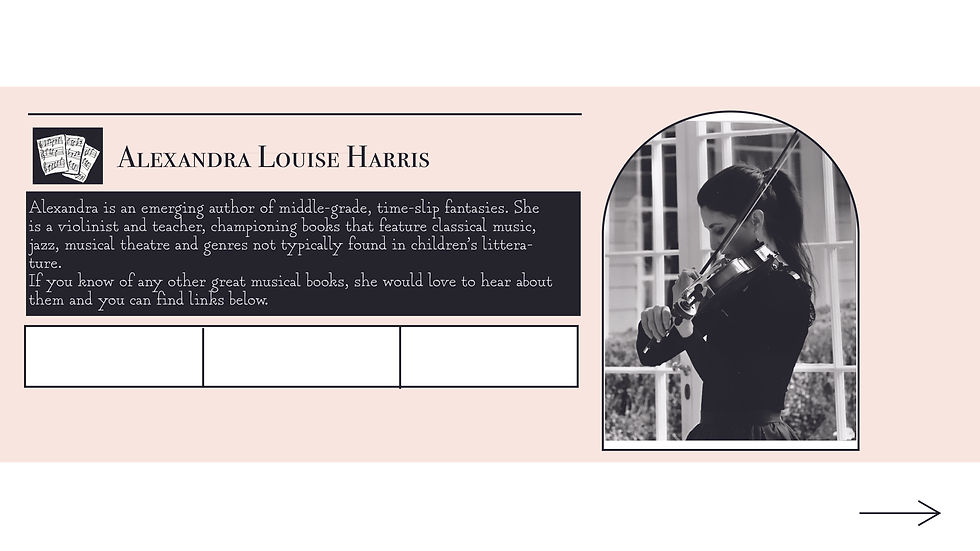The Butterfly Club
- Alexandra Louise Harris

- Nov 6, 2023
- 4 min read
Updated: Mar 3, 2024

A middle-grade mystery always appeals to me, and this one’s set in Paris! Not only that, the protagonists are a group of canny time-thieves, travelling to the year 1911—from England 1894–to steal the Mona Lisa from the Louvre. They crack the code of Codex Arundel, written in mirror writing, and embark on a search to find the Salvator Mundi. A difficult mission indeed, so it’s probably a good idea they involved the Great Houdini himself and a glacier named Vincenzo Perugga, who becomes entranced by the beauty of the Madonna.
By the way, isn't the cover marvellous?
Anyway, you are no doubt familiar with the magician Harry Houdini, otherwise known as Ehrich Weisz, but I didn’t realise Vincenzo Perugga was the actual thief who stole the Mona Lisa. I really should have, I know, but that’s the wonderful thing about reading books like this. In fact, I went down a slight a rabbit hole after reading that the author, M.A. Bennet, watched the documentary Mona Lisa is Missing and that the Codex Arundel is available to read online!
You can find an interview with the author here.
Now, I must prepare you for some plot spoilers. However, in the interests of learning from these books—particularly this one that jumps around in time—the plot is pretty important.
The journey begins in London 1894. The time-thieves—Luna, Aiden and Konstantin—are tasked with their mission and ride off in the H.G. Well’s Time-Train with Houdini to Paris 1911. Until about midway through the novel, the story centres around the Louvre, with a little back and forth to hotel rooms. Then, Vincenzo’s arrested. He goes to prison, positioned above the catacombs, and once the time-thieves break him out, he returns to his home in Florence, Italy.
As Vincenzo says: ‘Italy is my magic place.’
Then, the time-thieves and Houdini travel to Florence. ‘If Paris was a city of silver, Florence was a city of gold.’ They choose the year 1914 on the brink of war, construct an underwater diving suit from the plans in Davinci’s Codex Arundel, and rescue the Salvator Mundi from beneath the Il Ponte Buriano. Their arch-nemesis, an investigator named Arthur John Priest, almost kills Aiden whilst he is underwater, and in the stress, Konstantin’s clock-work heart stops! The stakes are indeed very high. In the dark moment of the soul, Aiden’s life flashes before his eyes. However, they recover the Salvator Mundi and live to tell the tale. They discover it is a painting of Jesus—looking very much like Mona Lisa—holding a crystal ball, said to have been painted for the French King.
It also has the spiritual power to save the world. However, something is waiting around the corner. The newspaper reads:
La guerra è dichiarata.
War is declared.
‘Take the Salvator Mundi and show it to everyone,’ says Vincenzo. ‘If ever the world needed a saviour it is now.’ With a few pages to go, the time-thieves leave Vincenzo to enlist in the army. They return to Paris in 1919, to check on the painting, but there they have a surprise visit. It’s Vincenzo. He’s alive, and he’s in love… and his wife is pregnant!
Finally, to round things off, they return home. Luna, disenchanted with the double-crossing Butterfly Club, decides she won’t have a bar of it. She wanders off and… jumps off a cliff.
Of course, she doesn’t literally jump off a cliff, but the story leaves us hanging. I've heard many people don’t enjoy cliff-hangers and I have to say I agree. The question of the deceptions of the Butterfly Club needed to be resolved, but I think the story felt much more complete before they returned home.

Now, before I talk about what I learnt, I must mention the music. I admit, there isn’t a lot, but… there is a singing clockwork bird. Cronos lives in the clock face of the time-train. It is indeed a very magical piece of machinery, and I had an idea to form a Violetta symphony from these musical middle-grade books.
I’ll provide more details in the next instalment.
So what did I learn? Mostly that the confusion of jumping around time periods is more succinct by not moving around too much once we arrive. Having just finished the final version of Violetta 2—after re-writing it a thousand times—I can also see that we don’t really need directions. Lefts, rights and the ‘legwork’ of moving around can be simplified, probably still further if I think about it…
While my brain is hurting from that revelation, the bigger mystery of the Butterfly Club was also intriguing. Saving the world. The team employs the Butterfly Effect—which incidentally I stumbled upon last summer when the butterflies in our local gorge inspired Violetta 3. They can change one small thing, like returning the radio to the Titanic, but nothing larger like preventing world war. I also liked the hint of a bigger mystery woven into the series, questioning the integrity of the secret Butterfly Club’s missions.
In fact, there is a lovely letter from Luna at the beginning of the book which draws you into the mystery and fills in any gaps from the previous books. Although this is book 3, it fortunately reads as a stand-alone. Another great trick.
Most of all, however, I loved that genuine characters and events were so cleverly woven into the narrative. The information didn’t feel clunky or confusing, and in fact, it was so vivid; I felt like I was really in Paris, or swimming beneath the bridge in Florence.
I do hope I haven’t given away too much of this splendid story, and if you read it, I’d love to know what you think. I’m also on the lookout for more instruments to join the Violetta Symphony, so if you come across more middle-grade musical books, let me know!
Happy reading!

#Butterflyclub, #Middlegradebooks, #childrensbookssetinparis, #musicalbooksforchildren, #historicalmiddlegradebooks




Comentarios